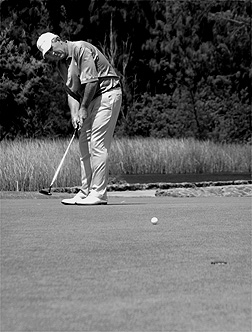
. |
|
 ..........................Photo: John Baer/Oahu Island News |
To most people, grass is green, fun to lie on and a chore to mow. To a golfer, the quality of grass is the difference between a great round and a club-bending day of disappointments. To a professional golfer, it may be the difference between going home empty handed or taking home a check for $225,000. And to a golf course superintendent, the |
|
right grass must survive anything – from divots to drought, golf
carts to sea spray, and tourists to tournaments. It’s
a little early to tell where the development of Sea Isle 2000
Paspalum, a new heat, drought and saltwater tolerant hybrid of an
old African turf grass, fits on the superintendent’s wish list,
but those who have witnessed and been a part of the development of
this grass see a potential revolution in the works. In
1993, Dr. Ron Duncan began research at the University of Georgia
Turf Center on a new strain of turf grass. After experimenting with
various strains in research conditions, he came up with this newest
hybrid of turf grass, Sea Isle 2000 Paspalum. “I was shaking out
various strains by cutting them down to one-eighth of an inch –
green height – and seeing if they could withstand the tolerances
at that level,” he said. At
that time, no Paspalum grass had ever been specifically developed
for putting greens. “We put it on USGA spec green, and it worked
out great; that’s when we knew we had something special.” said
Duncan. Sprigs
of the new Sea Isle 2000 Paspalum were shipped to growers in early
2000. “To have a grass that has this kind of flexibility and
durability is a very positive development for grass,” said Duncan.
“You’re going to get storm surges. You’re going to get high
water tables where the salt water at high tide works up into the
root systems. It’s just a fact of life; Bermuda grasses have
struggled because of their saltwater intolerance. To now have a
grass that isn’t affected by those conditions is pretty good
stuff,” Duncan said. The
new grass was put to the ultimate test this past October during the
Senior PGA Tour held on the Palmer Course at Turtle Bay. This was
the first sanctioned event using the new Sea Isle 2000 Paspalum
greens. It appears that Duncan’s hopes and dreams of creating a
new turf grass have come true as the Senior PGA Tour players were
all very impressed with the tournament greens. The comments were all
very positive, and that’s something to smile about, as Senior PGA
Tour players are notoriously known to be tough critics. “There’s
no grain on the putting surface, as opposed to Bermuda grasses,
which are known for that,” Duncan said. “There’s a much denser
canopy, so the ball sits up.” According
to Turtle Bay course superintendent Mike Honma, “The greens are
rolling great, there’s no grain in them, and they’re putting
true.” “Sea
Isle 200 Paspalum is also very environmentally friendly, which is
catching a lot of people’s eyes,” Duncan said. “Being able to
use alternative water sources is a big benefit. Plus, it’s about
half the maintenance costs of other warm weather grasses. It takes
half the nitrogen of other Bermuda grass.” “In
a salt-challenged environment, you need virtually no herbicide. Salt
is toxic to a lot of insects, so with the right salt water
management, we’re seeing a reduction in the amount of pesticides
used. There is no perfect grass, but this one shows a lot of
positives.” Sea
Isle 2000 Paspalum is saline tolerant, and because of this it will
grow and thrive in links environments where golf course development
has, to date, been impossible. So far, the Sea Isle 2000 has been
used to build two seaside courses in the Dominican Republic, and
courses from Naples to Nassau are experimenting with it. Duncan
also knows that the word-of-mouth exposure will be crucial, and
according to all accounts, the new grass is on its way to becoming a
regular on the professional tour. |
|